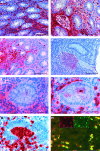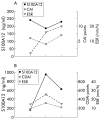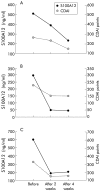Neutrophil derived human S100A12 (EN-RAGE) is strongly expressed during chronic active inflammatory bowel disease
- PMID: 12740341
- PMCID: PMC1773692
- DOI: 10.1136/gut.52.6.847
Neutrophil derived human S100A12 (EN-RAGE) is strongly expressed during chronic active inflammatory bowel disease
Abstract
Background: Intestinal inflammation in Crohn's disease (CD) and ulcerative colitis (UC) is characterised by an influx of neutrophils into the intestinal mucosa. S100A12 is a calcium binding protein with proinflammatory properties. It is secreted by activated neutrophils and interacts with the multiligand receptor for advanced glycation end products (RAGE). Promising anti-inflammatory effects of blocking agents for RAGE have been reported in murine models of colitis.
Aims: To investigate expression and serum concentrations of S100A12 in inflammatory bowel disease (IBD).
Methods: We performed immunohistochemical studies and immunofluorescence microscopy in biopsies from patients with CD and UC. S100A12 serum concentrations were analysed using a sandwich ELISA.
Results: Immunohistochemical studies revealed profound expression of S100A12 in inflamed intestinal tissue from IBD patients whereas no expression was found in tissue from healthy controls. Staining for S100A12 during chronic active CD and UC was restricted to infiltrating neutrophils. Serum S100A12 levels were significantly elevated in patients with active CD (470 (125) ng/ml; p<0.001, n=30) as well as those with active UC (400 (120) ng/ml; p<0.01, n=15) compared with healthy controls (75 (15) ng/ml; n=30). Even in inactive disease, elevated serum concentrations were found, at least in CD. S100A12 levels were well correlated with disease activity in CD and UC.
Conclusions: We demonstrated that neutrophil derived S100A12 is strongly upregulated during chronic active IBD, suggesting an important role during the pathogenesis of IBD. Serum S100A12 may serve as a useful marker for disease activity in patients with IBD.
Figures





Comment in
-
Serum S100A12 as a new marker for inflammatory bowel disease and its relationship with disease activity.Gut. 2010 Dec;59(12):1728-9; author reply 1729-30. doi: 10.1136/gut.2009.194100. Epub 2010 Aug 23. Gut. 2010. PMID: 20732921 No abstract available.
References
-
- Sartor RB. Pathogenesis and immune mechanisms of chronic inflammatory bowel diseases. Am J Gastroenterol 1997;92:5–11S. - PubMed
-
- Brandtzaeg P, Haraldsen G, Rugtveit J. Immunopathology of human inflammatory bowel disease. Springer Semin Immunopathol 1997;18:555–89. - PubMed
-
- Nusrat A, Parkos CA, Liang TW, et al. Neutrophil migration across model intestinal epithelia: monolayer disruption and subsequent events in epithelial repair. Gastroenterology 1997;113:1489–500. - PubMed
Publication types
MeSH terms
Substances
LinkOut - more resources
Full Text Sources
Other Literature Sources
Research Materials
Miscellaneous
